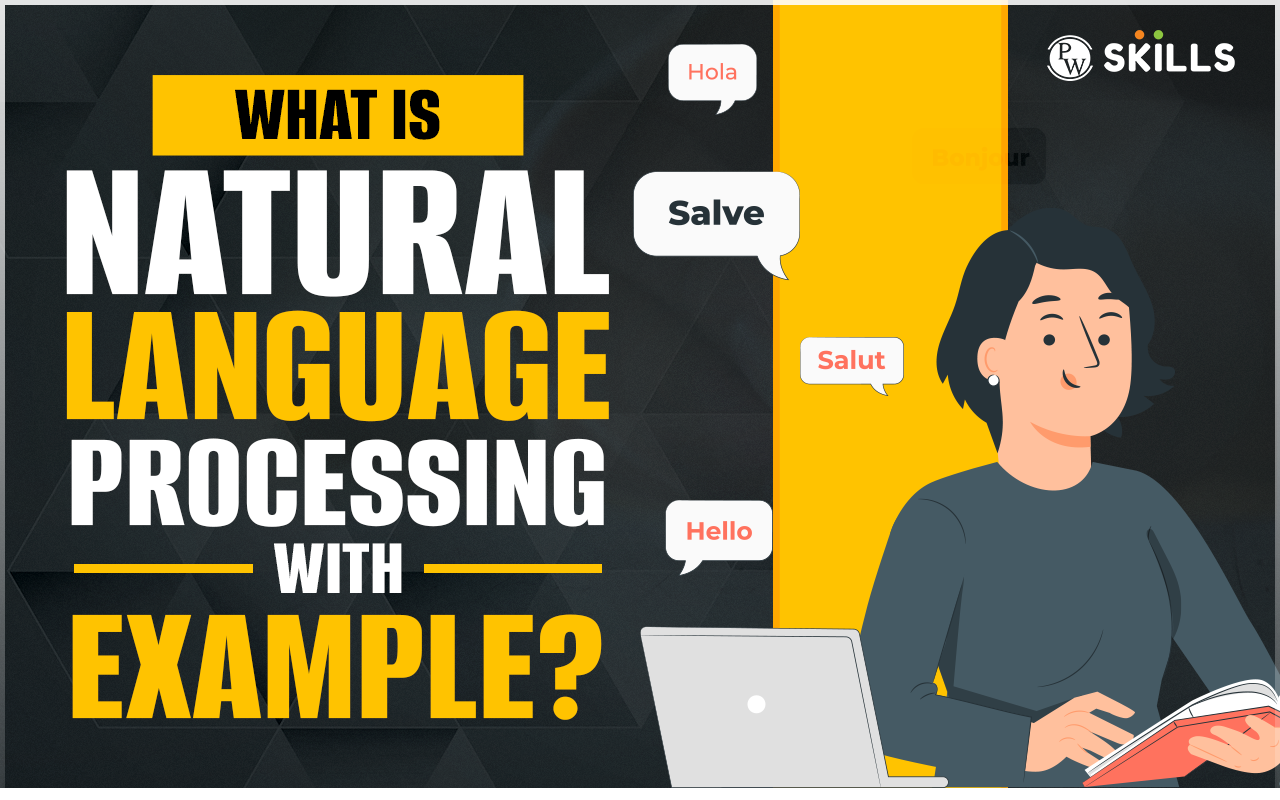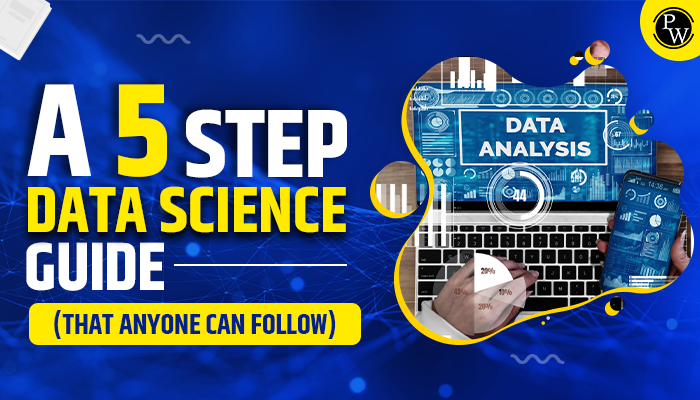Natural Language Processing in Data Science: In today’s digital age, the sheer volume of textual information available on the internet and in various databases poses a significant challenge for individuals and businesses. How do we make sense of this vast amount of unstructured data?
This is where Natural Language Processing (NLP) comes into play. NLP is a field of artificial intelligence focusing on the interaction between computers and humans using natural language. In this blog, we’ll talk about natural language processing in data science, its tasks, use cases, data science NLP in Python, and much more!
If you want to become a successful and high-paid data scientist, then the Data Science with ML 1.0 can help you a lot! This course equips you with the expertise to become a sought-after data scientist. Hands-on projects, industry connections, and job assurance await. Enroll now and unleash your data science superpowers.
What is Natural Language Processing in Data Science?

At its core, Natural Language Processing (NLP) is a facet of artificial intelligence. It enables machines to understand, interpret, and produce text resembling human language. NLP’s primary aim is to narrow the divide between human communication and computer comprehension. Unlike structured data, which is orderly and easily scrutinized, unstructured text data presents a distinctive challenge due to its intricate nature and variability. NLP’s domain surpasses simple language understanding; it covers a broad spectrum of tasks, from basic text handling to intricate language creation. Through the use of computational linguistics and machine learning methods, NLP algorithms can derive meaningful insights from text data. This empowers machines to fathom and react to human language in ways once deemed implausible.
Also read: Automated Machine Learning: What It Does, How It Helps, Examples
Natural Language Processing in Data Science Tasks
Natural Language Processing (NLP) tackles distinct language challenges through various tasks. These tasks intend to aid machines in grasping, interpreting, and generating text with a level of sophistication akin to human linguistic capabilities.
Tokenization and Text Preprocessing: Decoding the Language Matrix
At the core of numerous NLP endeavours lies tokenization, a vital process of breaking down text into smaller units, such as words or phrases, termed tokens. Tokenization serves as a crucial initial step in text analysis, converting raw text into a format suitable for subsequent processing. Alongside tokenization, text preprocessing involves techniques such as removing stop words, stemming, and handling special characters. This ensures that the subsequent NLP tasks operate on refined and standardised data, enhancing the accuracy of the analyses.
Part-of-Speech Tagging: Unveiling Grammatical Insights
Identifying grammatical categories, like nouns or verbs, for every word in a sentence is part of speech tagging. This task enhances comprehension of a text’s structure, helping machines recognize roles and connections among words. For instance, identifying nouns and verbs aids in extracting the subject-verb-object structure of sentences, a fundamental step in language comprehension.
Named Entity Recognition (NER): Identifying the Who, What, and Where
Named Entity Recognition (NER) takes text analysis to a higher level by identifying and classifying entities within the text. Entities can include names of people, organisations, locations, dates, and more. NER is crucial for information extraction, allowing machines to discern and categorise specific pieces of information within a larger context. In applications like news article analysis, NER helps identify key players, locations, and events, facilitating a deeper understanding of the content.
Sentiment Analysis: Deciphering Emotions in Text
Sentiment analysis, also known as opinion mining, involves determining the emotional tone expressed in a piece of text. This task classifies the sentiment as positive, negative, or neutral, providing valuable insights into the subjective aspects of communication. Businesses leverage sentiment analysis to gauge customer opinions, monitor social media sentiments, and make data-driven decisions to enhance products or services.
Machine Translation: Breaking Language Barriers
In machine translation, a key domain for NLP, systems like Google Translate use advanced algorithms. These algorithms analyse sentence structure and semantics to achieve accurate and coherent translations between languages. This application has far-reaching implications, fostering communication and collaboration across diverse linguistic landscapes.
Text Summarization: Condensing Information for Clarity
Text summarization is the process of distilling the essential information from a large document into a concise summary. NLP-driven summarization techniques aim to preserve the core ideas while eliminating redundant or less important details. This task is invaluable in scenarios where quick comprehension of lengthy documents is necessary, such as in news articles, research papers, and legal documents.
Speech Recognition: Transforming Spoken Words into Text
NLP extends its reach beyond written text to the realm of spoken language through speech recognition. This task involves converting spoken words into written text, facilitating applications like voice assistants, transcription services, and voice-activated devices. Speech recognition relies on complex algorithms that analyse audio signals and interpret them as meaningful linguistic units.
Natural Language Processing in Data Science Use Cases
Natural Language Processing (NLP) has transcended its theoretical roots and found a multitude of applications across diverse industries. As machines become more adept at understanding and generating human-like text, NLP is proving to be a transformative force, reshaping the way we interact with technology and harness the power of textual data.
Conversational Agents (Chatbots): A New Era of Customer Interaction
NLP has ushered in a new era of customer service and interaction through the development of conversational agents, commonly known as chatbots. These intelligent systems employ NLP algorithms to engage in natural language conversations with users, providing instant assistance, answering queries, and guiding users through various processes. From website-based chat support to virtual assistants on mobile devices, chatbots enhance user experience by providing real-time, personalised assistance.
Virtual Assistants: Seamless Integration into Everyday Life
Virtual assistants, such as Siri, Alexa, and Google Assistant, have become ubiquitous in modern life, seamlessly integrating NLP to understand and respond to voice commands. These digital companions leverage sophisticated NLP models to interpret natural language queries, perform tasks, and provide information. From setting reminders and sending messages to controlling smart home devices, virtual assistants showcase the practical impact of NLP in enhancing user convenience and accessibility.
Customer Feedback: Shaping Business Strategies
Sentiment analysis stands as a pivotal aspect of scrutinising customer feedback. In the realm of e-commerce, data scientists can utilise NLP techniques to assess customer reviews, extracting valuable insights into overall sentiment. This information proves invaluable for businesses aiming to comprehend customer satisfaction, pinpoint areas for enhancement, and make informed, data-driven choices to refine products or services.
Language Translation Services: Bridging Global Communication Gaps
NLP has revolutionised language translation services, breaking down linguistic barriers and enabling seamless communication across different languages. Platforms like Google Translate leverage advanced NLP models to accurately translate text, making information accessible to a global audience. This has profound implications for international collaboration, travel, and the dissemination of knowledge across diverse cultural and linguistic landscapes.
Healthcare and Biomedical Applications: Enhancing Clinical Insights
In the healthcare sector, NLP plays a crucial role in extracting valuable insights from unstructured medical texts. NLP algorithms analyse electronic health records, clinical notes, and research literature, aiding in disease diagnosis, treatment planning, and medical research. By transforming textual data into structured information, NLP contributes to more informed decision-making by healthcare professionals.
Also read: The Role of Data Science in Healthcare Industry in 2024
Finance and Stock Market Analysis: Unravelling Market Sentiments
Financial institutions harness the power of NLP for analysing vast amounts of textual data, including news articles, financial reports, and social media content. By gauging market sentiments and identifying relevant information, NLP assists in making data-driven investment decisions, predicting market trends, and managing risks in the dynamic world of finance.
Legal Document Analysis: Streamlining Legal Research
Legal professionals benefit from NLP in document analysis and legal research. NLP algorithms aid in extracting key information, identifying relevant clauses, and summarising legal texts. This accelerates the often time-consuming process of legal research, allowing lawyers and legal scholars to focus on higher-level analysis and decision-making.
Natural Language Processing in Data Science Examples
Data science, as a multidisciplinary field, harnesses the power of Natural Language Processing (NLP) to extract meaningful insights from vast amounts of textual data. Through various NLP techniques, data scientists can uncover patterns, sentiments, and valuable information embedded in unstructured text. Let’s delve into specific examples that showcase the practical applications of NLP in the realm of data science.
Text Classification for Spam Detection: Defending Inboxes with NLP Precision
In the realm of email security, data scientists leverage NLP to build robust text classification models for spam detection. By analysing the content of incoming emails, these models can discern patterns indicative of spam, helping filter out unwanted messages and enhance overall email security. Through the identification of key features and linguistic cues, such models can accurately distinguish between legitimate and potentially harmful emails.
Example: A data science team develops a text classification model that, based on the analysis of email content, accurately identifies and filters out spam messages. This example demonstrates how NLP can be a powerful tool in maintaining the integrity of communication channels.
Named Entity Recognition for Information Extraction: Unlocking Insights from Unstructured Data
In information extraction tasks, data scientists employ Named Entity Recognition (NER) to identify and categorise entities within unstructured text. For financial analysts, this might involve extracting key information from news articles or reports. By identifying entities such as company names, dates, and financial figures, NER contributes to the creation of structured datasets that can be analysed for market trends and investment decisions.
Example: A data science team utilises NER to extract relevant entities from financial news articles, allowing them to analyse and interpret market trends. This showcases how NLP enhances the efficiency of information extraction from diverse textual sources.
Emotional Analysis for Customer Feedback
In the realm of e-commerce, sentiment analysis stands as a pivotal component of feedback evaluation. Data scientists can employ NLP techniques for customer review analysis, revealing insights into overall sentiment. This intel proves invaluable for businesses, aiding comprehension of customer satisfaction, pinpointing areas for enhancement, and facilitating data-driven decisions to elevate products or services.
Example: A data science team implements sentiment analysis on a dataset of customer reviews for an e-commerce platform. By categorising reviews into positive, negative, or neutral sentiments, they provide the business with actionable insights to improve customer experience.
Data Science Natural Language Processing (NLP) in Python
Python is a popular programming language in the field of data science, and several libraries make NLP implementation accessible to developers and data scientists.
Overview of NLP Libraries in Python
Python boasts several NLP libraries, including NLTK (Natural Language Toolkit), SpaCy, and TensorFlow. These libraries provide a rich set of tools and functionalities for implementing various NLP tasks.
Introduction to NLTK and SpaCy
NLTK is a powerful library for NLP, offering tools for tasks like tokenization, stemming, and part-of-speech tagging. SpaCy, on the other hand, is known for its speed and efficiency in processing large volumes of text.
Building an NLP Pipeline in Python
Data scientists often create NLP pipelines to streamline the process of text analysis. These pipelines typically include tasks like tokenization, preprocessing, and feature extraction, leading to the development of robust NLP models.
Example: Implementing Sentiment Analysis with NLTK
In this example, we’ll explore a basic sentiment analysis implementation using NLTK. This will involve tokenizing and preprocessing text data, building a sentiment analysis model, and evaluating its performance.
Also read: 7 Best Artificial Neural Networks for Natural Language Processing
Conclusion
Natural Language Processing is leading the tech revolution, changing how we engage with machines and handle text data. From basic functions to practical uses in data science, NLP is crucial in shaping AI’s future. Watching the ongoing progress in this area reveals that the connection between human language and machine intelligence could reshape how we talk, process information, and decide things. Embracing NLP’s capabilities opens up a world where machines not just grasp our language but actively contribute to our pursuit of knowledge and comprehension.
FAQs
How does Natural Language Processing (NLP) contribute to email security?
NLP plays a crucial role in email security by enabling the development of text classification models. These models analyse the content of incoming emails to accurately identify and filter out spam messages, enhancing the overall security of communication channels.
Can NLP be applied to financial analysis?
Absolutely. Named Entity Recognition (NER), a key NLP task, is employed in financial analysis to extract relevant entities from news articles and reports. This includes identifying company names, dates, and financial figures, contributing to the creation of structured datasets for market trend analysis.
How does sentiment analysis benefit e-commerce businesses?
Sentiment analysis in e-commerce involves using NLP techniques to analyse customer reviews. This process provides businesses with valuable insights into customer satisfaction, identifies areas for improvement, and facilitates data-driven decision-making to enhance products and services.
In what ways does NLP contribute to legal document analysis?
NLP, specifically through text summarization techniques, aids in legal document analysis by distilling essential information from lengthy documents. This allows legal professionals to quickly comprehend and extract crucial details from contracts, court rulings, and other legal texts.
Can NLP be used to enhance healthcare practices?
Yes, NLP finds applications in healthcare by extracting valuable information from medical records and clinical notes. It aids in disease diagnosis, treatment planning, and overall healthcare management through the analysis of unstructured textual data.




